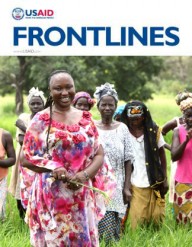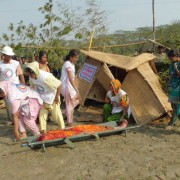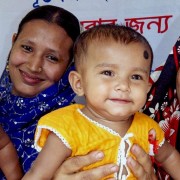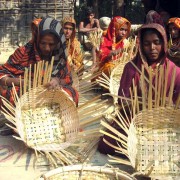Mohammad Mofizul Islam Gazi is a farmer and father of two living on the front lines of climate change in southern Bangladesh—one of the most vulnerable areas in all of Asia to cyclones and sea level rise.
In his village of Sutarkhali, he harvested rice—the most popular crop in his home country—on a small plot of land from which he was able to feed his family. But May 25, 2009, changed his life forever. Cyclone Aila unleashed her fury across the southern coast of Bangladesh and into West Bengal in neighboring India, and claimed everything Gazi and his family owned.
“We were devastated,” said Gazi. “Cyclone Sidr [in 2007] couldn’t destroy us, but Cyclone Aila nailed the last pin in the coffin. There was nothing left.”
The cyclone began as a moderate disturbance as it crept toward the coastline of Bangladesh. However, the warm waters of the Bay of Bengal fueled the tropical storm, transforming Aila into a full-borne cyclone as it made landfall. A tidal wave ripped through the Sundarbans, the world’s largest mangrove forest, displacing thousands of villagers. This surge of saltwater swept through the region devouring trees, vegetation and precious farmland that provides people like Gazi their chief source of food and income.
Cyclone Aila hit one of the most underdeveloped areas in Bangladesh, leaving more than 200,000 homeless in a region where survival includes tackling extreme poverty and a regular onslaught of floods.
After spending several days at a cyclone shelter, Gazi and his wife and children returned to where their home once stood. “All we had left after Aila was a single pillar of the house,” said Gazi.
He and other villagers also discovered that saltwater had infiltrated the paddies where they used to grow rice and vegetables. As time went on, they also noticed the crops they used to cultivate were not producing the same amount of harvests. Before the storm, the typical bigha—a rice field measuring approximately one-third of an acre—could produce up to 200 kilograms of rice. After Aila, farmers were only able to produce 70 kilograms on the same plot of land.
“The water didn’t move for months,” recalls Gazi, “and when we tried to grow crops, we couldn’t. We were spending money and energy in vain. There was literally nothing that was growing well in the fields and our village was suffering from malnutrition, with no job opportunities and with no food.”
A New Way to Grow
In 2012, a USAID agriculture program introduced Gazi and several other farmers in the area to new varieties of rice seeds. “They told us these were saline- and submergence-tolerant seeds,” he said. “Seeing no other alternative, I and my other fellow farmers got some seeds from them and sowed them into our piece of lands.”
In partnership with international research institutes and with support from USAID, the Bangladesh Rice Research Institute developed flood- and saline-tolerant varieties of rice that produce higher yields. Rice plants grown using these improved seeds can survive between 12 and 14 days when completely submerged underwater, compared with traditional rice varieties that can only endure three or four days of submersion. For the most vulnerable country in the world to cyclones and sixth-most prone to flooding, these appear to be the perfect seeds to plant.
Developing rice seeds that can withstand soil salinity and prolonged submersion in water was a difficult process that required more than 10 years of testing and research, recalls Jiban Krishna Biswas, director general of the Bangladesh Rice Research Institute. “The first challenge was creating a laboratory suitably equipped for testing these improved seeds. My team of scientists and I feel encouraged and proud to take part in this process, which can help farmers in Bangladesh and other developing countries become more resilient to natural disasters.”
The farmers in Sutarkhali learned to plant their fields using the newly developed rice varieties. They also learned how to store and save these improved seeds to use in the following season’s rice crop. Now, they are harvesting between 250 and 300 kilograms of rice per bigha—up to 50 percent more than they produced before Cyclone Aila hit.
Gazi’s paddy also requires less fertilizer and pesticide, helping him save money he previously poured into his field to help feed his family. In addition, he and his wife preserved rice seeds for future use and sold the leftover seeds to several neighboring farmers.
“Before, I used to grow about 150 kilograms of rice in one bigha. Now, with less fertilizer, seed and pesticide, I can grow more than double what I used to grow in the same piece of land before Aila hit,” Gazi said.
Rice Growing, Poverty Lingering
Rice production in Bangladesh has tripled over the last 30 years, while the poverty rate has declined by 15 percent over the past decade. Despite these gains, 40 percent of the population currently lives below the poverty line.
Forty-eight percent of Bangladeshis are employed in the agriculture sector in a country that is one of the world’s largest producers of rice, tea, jute, potatoes, mangoes and onions. However, population growth, urbanization, and soil and natural resource depletion have resulted in the degradation of land and bodies of water. This poses a significant threat to the agriculture sector in Bangladesh. Rising sea levels, frequent flooding and extreme weather patterns compound the threats to food security.
“Investing in agricultural growth and innovation is an important way to fight both hunger and poverty, especially in rural areas where people rely on their land to survive,” says Ramona El Hamzaoui, chief of USAID’s agriculture and food security programs in Bangladesh. “This is why our Feed the Future activities concentrate on some of the most vulnerable areas in southern Bangladesh. We strive to help poor farmers increase their resilience to flooding and severe weather, and stabilize their income through improved technologies and diversified crops.”
In 2013, USAID helped approximately 350,000 farmers adopt high-yielding, stress-tolerant rice varieties in southern Bangladesh. In Sutarkhali, USAID initially reached out to about 50 families, including Gazi, to demonstrate the benefits of planting flood- and salt-tolerant rice. The seeds produced from these homestead farms were used by neighboring farmers for the next season of rice cultivation, and use continues to expand throughout the area.
“By addressing some of the most important needs—access and availability of important food resources—Sutarkhali has emerged from the wrath of Cyclone Aila and farmers are growing more rice than before,” says El Hamzaoui. “Farmers are able to farm again, families are able to eat, and the village is more resilient as a result.”












Comment
Make a general inquiry or suggest an improvement.